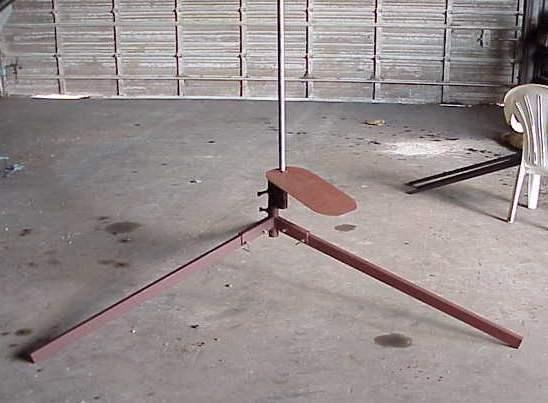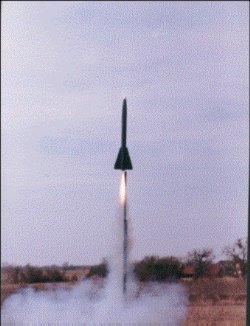Randy Ashley RGV High Power Launch Pad
Randy Ashley - RGV High Power Launch Pad {Launch Pad}
Contributed by Alex Mericas
| Manufacturer: | Randy Ashley |
Brief:
The RGV pad from Randy Ashley is a High Power pad designed for use with BlackSky's Launch Rail.

Late in December 1999 I was putting the finishing touches on my Level 2 rocket. The NASA/Houston Rocket Club was planning a High Power launch for January 1 at Bomber Field near Houston and I wanted to do my certification flight there. The Austin Area Rocketry Group received a Blacksky Launch Rail and I quickly decided to use a rail for my level 2 rocket. At the launch I was very impressed with a launch pad made by Randy Ashley that included a Blacksky rail mounted to a steel pipe and then supported by a very sturdy steel tripod. Afterwards I talked to Randy about his pad and decided to order one for the Austin Area Rocketry Group (AARG).
Construction:
The launch pad consists of a rotating turret mounted on three steel legs, AARG’s pad uses four foot long legs but Randy also makes three foot long legs. The turret allows for full 360 degree rotation and also has a tilt head that will allow the rail to be tilted to horizontal to make loading the rocket easier (no more standing on ladders!). A hefty blast deflector is provided, angled slightly downward. The launch rail is mounted to a steel pipe that is one foot longer than the rail. The steel pipe is inserted into the turret and secured using two large bolts. The turret can also accommodate ¼ inch or larger launch rods. Since AARG already had a rail we asked Randy to provide the pipe only. Pipes can be purchased for 4 foot or 6 foot sections of rail. Since our launch field only supports Large Model Rockets I went with a 5-foot pipe, sufficient to support a 4-foot rail.
The rail mounts to the steel pipe without drilling the rail, the screw heads are held in the back side of the rail using the same slot that the back bone connector (used to join multiple rails together) uses. A rail attached to the steel pipe and mounted in the rotating turret will easily support most high power rockets, probably in excess of 100 pounds. For maximum support the pipe should support the entire length of the rail. However for smaller rockets (under 10 pounds) I think it is sufficient to have the bottom 4 feet of rail supported by pipe with another 2 feet of rail above that. Since the rail is inherently very stiff, the amount of flex on the short section is very small.
 The launch pad has been used twice since AARG purchased it. In both cases I found it very easy to set up, use, and tear down. The 4-foot long legs are too long to fit sideways in the back of my van, but they do fit longwise under the seats. In our configuration, a 4-foot rail mounted to a 5-foot pipe, the rail was rock solid. Even with an additional 2-foot rail attached the rail was far stiffer than even a ½ inch rod.
The launch pad has been used twice since AARG purchased it. In both cases I found it very easy to set up, use, and tear down. The 4-foot long legs are too long to fit sideways in the back of my van, but they do fit longwise under the seats. In our configuration, a 4-foot rail mounted to a 5-foot pipe, the rail was rock solid. Even with an additional 2-foot rail attached the rail was far stiffer than even a ½ inch rod.
The only deficiency the pad has is its finish, which is none. To save money Randy only painted the pad with a generous amount of primer. Powder coating would add a nice touch but would probably double the cost of the pad. AARG will probably add a top coat of high temperature paint, but this is for esthetics only, it doesn't affect the performance of the launch pad. The weld joints on the pad, while obviously very strong, look a bit rough. Randy has indicated that he might grind down the joints on future pads to make them look a bit nicer. Personally, I kind of like the rough look!
Summary:
Randy Ashley’s High Power Rail Launch pad is study, well designed, and easy to use for mid and high power rockets. Randy is very responsive to comments and suggestions regarding his launch pad and stands behind his product. Although not as portable as high power pads such as Rocket Vision’s Quad Pod, I think Randy’s lower price makes his launcher a better deal. I would easily recommend it to anyone looking for a good rail launcher. PROs: low cost sturdy construction and ease of use. CONs: "industrial" finish and difficult to transport.
Overall Rating: 4.9 out of 5
 |
 |